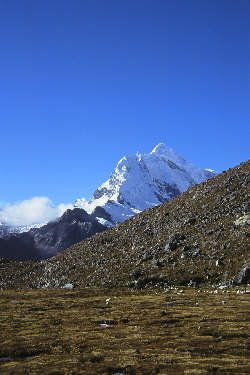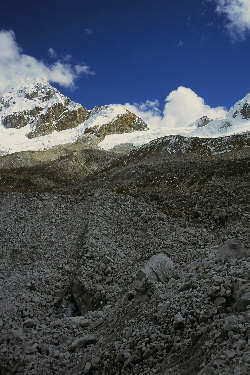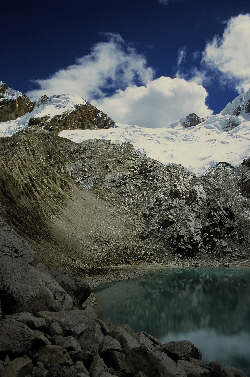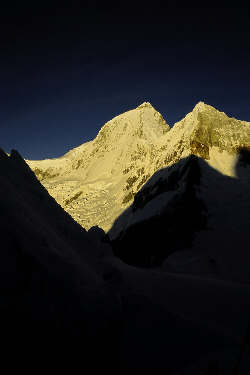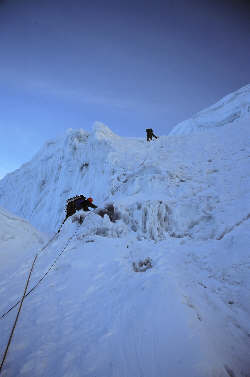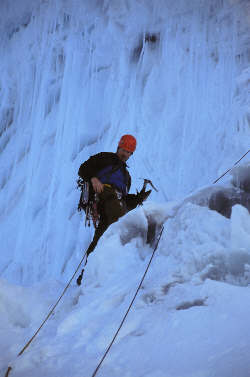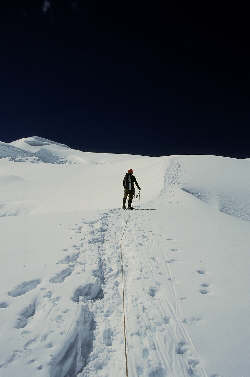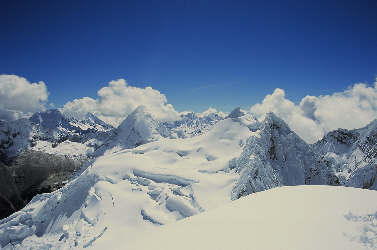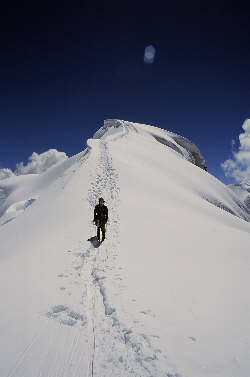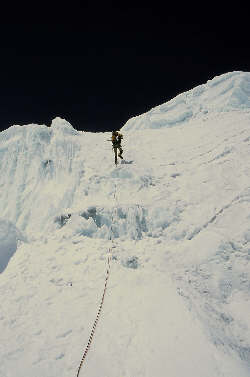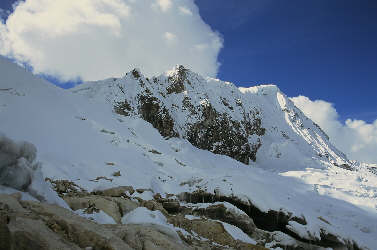|
||||||||||||||||||||||||||||||||||||
|---|---|---|---|---|---|---|---|---|---|---|---|---|---|---|---|---|---|---|---|---|---|---|---|---|---|---|---|---|---|---|---|---|---|---|---|---|
Nevado Pisco, Urus & Ischinca ExpeditionPisco Base Camp & Pisco ClimbDay 7 – Pisco Carry Day:July 7, 2004
Dawn arrived and brought clear weather, finally. The primal urge to climb was strong but we knew that another day of acclimatization was going to be needed to give us a fair shot at Pisco on the following day. But after all these days of rain and nights of snow, what would tomorrow bring . . . another period of bad weather? We convinced ourselves that the good weather would come 48 hour periods, based on comments made by other climbers who had been around since the start of the season.
Elias started the day off with stacks of pancakes onto which hard butter or a frozen glob of syrup could be placed. During breakfast we mulled over the options that we had to choose from in making our climb of Pisco the next day. The weather would be the key and it could give us either success or one miserable day after if the rains and snow returned after but a 24 hour break. We weighed the options.
We debated the options and chose #3 to meld an acclimatization hike with the advantage of a light weight approach the following morning. Decision made, we took all the technical gear, crampons, axes, . . . all but the bare necessities and packed them for the trip across the moraine and up the far slope. The moraine camp is not only across the way but at a higher elevation on the edge of a dry lakebed. The route crosses the moraine through the tussle of boulders on a trail that during the daylight is clear to see for any experienced climber. We figured that the trip across in the daylight would show the route and make the all too soon midnight crossing an easy affair by LED light. The three of us hefted the now heavy packs and took hold of the proffered box lunch as we left the camp to make the gar haul. Up the climbing trail we went and 45 minutes later we were atop the nearby ridge looking across to discern the proper path.
The trail drops off the near side down a dirt and boulder bank that if it chose to let loose. Would permanently ruin your trip. From there the path was well cairned but neceistated the use of your rock hopping skill part of the way through as your weave in and through large boulders. The crossing is pretty clear-cut and takes no more than 30 minutes to get across the bottom and begin the climb up through the are we saw moving so much the previous day. We put some distance between each of us and made the rtraverse without delay. Once past the active area, we made our way up the far bank of the moraine to the ridgeline leading steadily upward to the moraine camp basin. For those making the traverse for the first time, do not take the trail down to the lower lake but keep heading up the spine before traversing a short distance left to the moraine camp. The moraine camp lies on the rocky lip of a dry alke bed with a wisp of a stream running across the sandy center. There are six or eigh flat spots suitable for camping and the other group of Americans we met below were camped on one for the night before their attept of Pisco. We had chatted with them earlier to ask if they would watch our gear and they agreed as Elias and their cook had already struck the same deal for the base camp. We dropped our heavies for the night and took time for lunch before heading back to base camp for an early dinner and partial night’ sleep. Before doing so;however, we walked over to the cairn memorial placed on the path toward the Huandoys. Like I said, we were not in Kansas anymore and the engraved plaques with the names of climbers killed on the nearby peaks proved the fact.
We hoisted our now empty packs and headed on back down the trail to cross the moraine to our base camp. We played it safe again, putting a good bit of distance between us for the dicey stretch before bunching up again in conversation for the rest of the crossing. Eagle Eye Elias caught sight of us breaking the crest of the near moraine and by the time we dropped to the tent, dinner was well on its way, soup’s on. We finished off the usual volume of food and chatted about the departure time for the next day’s climb. Though Pisco did not look to be far away, we knew that we would be out for the whole of the day, starting with a midnight wakeup and one a.m. departure. We figured to hit the moraine camp at 3 a.m. (prior crossings both took 1:40) and make our way well up onto Pisco before sun-up. After making the gear haul, midnight was goind to come pretty damn early . . . if the weather held.
Day 8 – Pisco Climb:July 8, 2004
Before going on about our climb of Pisco, a word or two about the peak. Pisco is nestled between the Huandoys and Chacaraju and is about 19,000 feet high, most say a bit less, some say a bit more. It is generally considered an acclimatization peak, hence lots of folks climb it and it is not considered that hard. I think the pre 2004 rating was PD on the French scale. The route is mostly a glacier walk but this year a new ingredient was added to the otherwise plain Jane climb, a mixed ice and snow pitch up at about the 17,800 foot mark. Seems a hunk of the glacier that lies atop the peak moved, exposing a 50 meter pitch with a blue ice bottom and good neve snow top section. The pitch starts with a near vertical section at the base but most of the ice lays back at about a 70 degree angle. After 25 meters of ice, the pitch lays back into the 55 to 60 degree range and changes to wonderful neve snow. Before the mixed pitch the climb is a glacier walk, and much the same after the pitch, but for that one 50 meter stretch, the climb definitely presents a bit more challenge. Today, word has it that Pisco is rated AD-.
We woke all too soon and Elias had a warm but much lighter breakfast ready, rolls, jam and tea was about the extent that he prepared and about all any of us were interested in carrying, at least until the stomach converted the extra weight into potential vertical feet. We hoisted our packs right about 1 a.m. and figured we would have the moraine crossing over with and be racking our glacier gear in about two hours. We headed up the valley and soon were on the familiar traverse route that leads to the top of the near moraine ridge. We gained the ridge, thankful, for nearly empty packs, and then moved across the moraine proper. I led the route, being not too keen to socialize and honestly better left to my own devices at that hour of the morning. As much as I am the bound out of bed morning person at home, the first hour or so on any alpine start proves to be a predictable challenge as I seek a comfortable groove while generally trying to get my outlook out of my bum. So, I led the trip across the rock moat and G followed with Jim. Jim is really none to keen on rock, basically because most all of his leisure time is spend in the water. G and I by comparison train in Rocky Mountain National Park and rock hopping is a skill one must learn to climb at all. I went hopping along out ahead of the group and G and Jim followed perhaps 50 yards behind at a more leisurely pace. This method is not wholly disadvantageous as it gives the leader time to stop and find the route in the dark and the two behind need make no similar effort. Just follow that guy out front and if he turns and meanders to find the right path, you don’t wait, you simply catch up before he strikes out ahead for a bit. It works well for us and allows the followers to mindlessly trudge along in the dark.
We made our way across the moraine and up the far spine of a ridge to climb to the basin holding the moraine camp. As we expected, the other two groups that set up high camps were up and finishing off their breakfast before heading up Pisco as well. We chatted briefly and retrieved our gear from the hide next to one of their tents. Actually Jim and G got all the gear and I took the water bottles across the lake bed for a fill. Rather than lugging water for the climb to the moraine camp, we climbed with a half quart each to the high camp and then split the group to allow one person, me, to fill all six water bottles that were going to the summit while the other two took all the glacier gear and kept on climbing to the toe of the glacier. Again, it saves waiting around and reduces the thinking component to one person. The route from the moraine camp to the toe of the glacier is a continuation of the route up the spine of the moraine and then a rock scramble, Class 2 and 3, up a series of ledges that eventually lead to the start of the ice. Gary and Jim figured to get to the toe while I filled the bottles, sort out the gear and be ready for me to harness up and clip in for the rest of the climb. Did not quite work out that way, Jim was a bit on the slow side and I caught up to the two of them perhaps ten minutes before the start of the glacier. We trudged the rest of the way as a threesome once before coming to a halt to gear up. There were three groups on the peak that morning and as one can predict we all arrived at the base at the same time. Ten people all rummaging through packs and trying to get on the trail before the other. Not a race by any means but no one group really wishes to be the last group as doing so is sure to translate into a hold up at any pinch point on the route. The least result is a set of cold toes or a chill here and there but more worrisome would be a tough pitch that grinds all three groups to a halt. In such a case, the last group can easily lose out on a summit bid by running out of time and energy by just standing around.
We finally got our stuff together and Gary was not really a happy camper given that we were slow and last on the ice. Every group has folks who fill various roles over the course of the expedition. While my natural role is planner and then logistical jerk, Gary fills the bill as glacier travel expeditor. I do my job, perhaps well, and Gary does his, well. While I worry about the arrival of a taxi, Gary worries about seracs and softening snow. Takes all kinds and we have a good mix. Well, G was ready to move out and we were the tail end Charlies this morning. We did; however, get our stuff together and then we were on the glacier and moving. The route climbed steadily to the col separating the nearest Huandoy from the start of the Pisco summit ridge. There is a steep section here and there and a hole now and then but it is mostly a case of following a well packed path if you re in the lead and following that rope running through the snow in front of you for all but the leader. We trudged upward with the promise of dawn’s arrival fairly soon. Things just were not going right this morning, I was overrunning the rope and Gary was tugging Jim. Roped travel requires concentration and the ability to read the signals passed up and down the rope. The rope tells you what to do slow up, hurry up, and even the other guy is having a bad day. That was the signal Jim was sending both up and down the rope. We stopped to rest and then started again, then stopped and started. Just shy of the col, G stopped and queried Jim as to his condition. Jim said he was fine, but he wasn’t, he was doing the altitude bonk. Now don’t get me wrong, Jim is a tough character, tougher than I am, and he knows how to suffer, but we were not in Kansas and having a whacked partner at 19k is not my idea of fun. I speak from experience, having been dragged up the normal route of Athabasca in 2002, an experience I care not to repeat.
Jim and Gary conversed and decided we were ready to go, at which time, I came semi unglued. Not my usual behavior as G usually takes the firm stand on the snow and I tend to silently stick with the program he outlines. Not that morning, I just told Jim he was not going higher and that was my final stance. He accepted my position and we agreed that he would go down solo, only a few hundred very safe yards, and wait for sun up. Once the sun was up, he would descend the rock to the moraine camp and wait out the day. We’d pick him up on the way back. This was a tough move but I could not help but remember my own experience on the end of short rope and if I had it to do again, I would have preferred being sent down to getting dragged up. I’ve bonked and paid those dues. Jim headed down and G and I continued up. We gave Jim one of the Motorola radios and we took the other, that way we could keep in touch not only as he crossed the toe of the glacier but all through the day. Reduced to a rope of two, we picked up the pace and soon came upon the tail of the rope of four ahead of us. They let us pass and soon after, as the sun came up, we passed the rope of three that was in the lead up to this point. We were simply walking up the spine of the Pisco ridge, wondering where the storied ice pitch was that other groups had told of. The need for some mixed ice and snow climbing was no surprise, we had heard of it all the way back in Huaraz from returning climbers. We knew it was about ½ way up the back side and that it was guarded on both sides by gaping holes, ready to end the suffering of anyone making a foul up of the ice climb. We encountered steepening terrain and saw a trail branch to the right to a very steep ice wall. Could that be it . . . We were however on solid trail leading up a fin but upon reaching the top of this 50+ degree sucker trap, we recognized it for what it was, a dead end.
The other groups had now caught up and we yelled down for them to take the right option for our path was not going to get anyone to the summit. They went right and climbed to a small flat between the holes and below the 50 meter mixed pitch. Once again, we had three groups jockeying for who would take the first shot at the climb. The other two groups were guided, one with clients of little experience and the other with clients well acquainted with ice climbing. We made a go for the first spot but then the guide for the less experienced group asked if he could take a parallel lead. Sure why not? Did we learn nothing on the Silverhorn of Athabasca? It did not take too much falling ice to give us the idea to wait a bit and in that time, the other guided group stomped their feet and waited as well. We suggested that since their lead was a proficient ice climber, that they advance next and we would bring up the rear. The pitch just did not look that hard, so why not just let the others go up and then scamper up after them. Reality is often far different from appearance. We watched the guide for the less experienced group hack and whack his way up, set a belay and then bring all three clients up in one group, tightly spaced on the end of the belay rope. Meanwhile the ice crew worked their way up, but not without a good bit of stopping, looking for decent ice and then finally moving again but still in fits and starts for the first 25 meters. This was not going to be an easy pitch. Our mutual blue ice experience beyond perhaps 45 to 55 degrees was two pitches I led on the Flying Dutchman in Rocky Mountain Park. I ended up leading both of those short (7 meters) pitches so this time it was G’s turn to go first, I would handle the bottom end. After the last of the other two groups made it to the top and moved on toward the summit, we shook off the cold that had seeped in during the wait.
Gary was the lead and the plan was for him to take the half dozen ice screws we had and protect the hell out of the pitch. I would belay from the flat and if we ended up needing another 10 m of line or so, I would advance to the first screw at the base of the vertical portion of the climb. A good plan. Gary made his way to the first part and found it really consisted of two nearly vertical and very crappy ice steps. The ice simply would not take a screw. The ice would break away or it was just crap ice that was all eaten out behind like a piece of Swiss cheese. We’d heard of this type of ice in the Andes of Peru and now we were taking a first hand look at the storied stuff. G poked here and there but just found nothing that would adequately protect this should he take fall either low or higher up. In the meantime, I was in the throws of an imminent bowel movement and I told G that I was literally sweating this one out and could he please come back down just long enough for me to renew my mountain dues. He wanted a few more minutes that I did not have and finally, he stated that this pitch wasn’t going to go for him. Once he was down, I was relieved and five minutes later, I was ready to take a shot at the wall. I don’t think that either of us wanted to turn the climb at this point but we also did not want to strike out on a PD peak when the next peak we were planning to climb was a solid AD or higher grade. We knew were not doing walk-ups but were we really going to get sent home from the acclimatization peak? We agreed that I would give it one try and if I did not feel happy, I would come down and we’d go pick up Jim. I made my way to the vertical steps and found out just what he had described, garbage ice. I looked to the right where all looked easy from 30 feet away but found nearly vertical ice and no place to fall but into the crevasse. No first screw, no way to avoid that hole. I had to do something different.
I moved back to where G was the first time and finally found a hunk of good ice that took a screw. That gave me six feet where I managed to get another screw in. So far so good, two screws for a 4 meter advance, at this rate, I only needed 23 more screws to get to the top. I looked at the situation and figured I had enough pro to start getting out a ways. I had the two Shrikes so up I climbed, keeping my mind on the task at hand and the constant need to assure myslef that this was OK. I got up about 12 meters and put in another screw and then clipped into an older freebie ice thread soon after. I finally reached a point about 25 meters up the high angle ice and hung there on two axes. G yells to see if I’m Ok and I respond by telling him that I’m hyperventilating, out of breath, scared, but generally comfortable. I took a solid minute to get my breathing under control and then placed another screw to preclude the possibility of a 40 foot fall if things became specifically uncomfortable. I do not have a “no fear” sticker in my car window, I assure you. From the mid point on, the ice turned to neve snow and the angle lessened first to 60 degrees and then down to 55 or a bit less. I did a scamper on up the neve, stopping after about 12 more meters to place a picket and allow Gary to move up to the first screw. Then I had enough rope to go another 12 meters or so where I stopped first to breathe and then to build a secure belay station from which I could bring G up the pitch. I used my other picket and one of the Shrike axes to construct an equalized belay and then yelled for G to follow. He made his way up the slope in fits and starts. I was just worn out so the fits and starts seemed to take forever but actually they were simply short but very necessary stops to remove a screw and later a picket before continuing the climb. We exchanged more than a few yells for slack or pro before G came into sight, a sight which gave me a great sense of relief.
G climbed up the neve with ease and I advised him to simply pass by me and move on up the last 10 meters or so to the flat atop the pitch. I was beat and I wanted him to sit above to give me a belay once I pulled the anchors and turned to climb to the higher flat. He did so and soon enough I had the axe and picket in hand as we stood atop the pitch to coil the rope for the rest of the glacier climb. Before we moved on; however, we had to discuss the plan. We literally lost an hour waiting for the opportunity to climb the last 50 meters and then between the two of us and Bob we took another hour. Though we started at 1 a.m., we both realized that we might have lost the chance to summit on account of the delay and the warming snow. You must keep in mind, we sat in the base camp for two days listening to the avalanches roar off Huandoy, the fact that snow could move on this peak was not lost on us. We opted to continue but with the caveat that if the snow really started to soften, we would turn the climb. The route to the summit was obvious and really required no more than a roped glacier walk up the hill The only problem was we were both tired, a bit dehydrated and we needed to gain another 1000 feet. One thousand feet in the Rockies does not phase me, but I was beaten badly by the ice climb and the summit was about forever away from us. We started the trudge, both of us mentally breaking the path into easy flats and four, count them, four uphill stretches. We took them one at a time as they led us across some substantial crevasses and both near and far from the edge of Pisco’s ridge visible from our camp.
We got up the first slope, rested, the second with a few more rests, and so on, until the fourth where we dropped the extra rope and still rested a few times during the steep part. I got to the point I was not following G but simply watching the rope either snake ahead of me or stop, whereupon I stopped without looking up, waiting for the rope to again move. As bad as it seemed, we kept a pretty steady pace and started gaining on the other groups until they reached the summit. They rested a bit and then as we reached the final summit ridge traverse, they both came down to pass us just before we reached the summit. All three groups either had or now were going to make it and the leader of the first group that took so long to get his three clients up the ice pitch stopped and apologized for costing us two hours and possibly the summit. He’d read our minds and was enough of a gentleman to make amends. In an instant all was forgiven by his simple acknowledgement. We crossed a final crevasse and walked a bit of flat ground before reaching the summit of Pisco. It was 11 a.m. and we had been going for ten hours straight. We were tired but we were there. The vista that lay before us was impressive, the super hard climbs of Chacaraju lay just in front of us on the next mountain and the Huandoys lay behind us. In the distance we saw all the names that bring climbers to Peru: Huascaran, Chopicalqui, Pyrimide, Alpamayo, Artesanraju, all the big boys were there. We drank, we ate and I took the still shots that justified a new camera for this trip alone. After 25 minutes, we were of a mind to leave . . . now concerned more about the afternoon heat than anything else.
The trip down was certainly faster than the trip up but I for one was really drained and still feeling the fatigue generated by the ice climb. We wandered steadily along down and across the glacial hummocks until we reached the top of the ice pitch. The first group had just competed their descent and the slower guided group was about to get moving. Their guide made the offer of the day, “want to rappel down our doubled line?” This dude had made amends for sure and we took him up on this offer without a second of hesitation. The offer saved us from leaving a picket, or possibly two, in place and the time involved in making our own set-up.. This dude was better than OK. We made the fast trip down the pitch and then all three groups gathered their gear to make the trek off the glacier’s gentle lower slopes. The sun was now not a welcome sight . . . it had transformed into the body broiling opponent that we feared would arrive. I was too layered for its intensity and after no more than a few hundred yards, I simply had to stop and strip to the undershirt to keep from making the final down payment on a case of heat exhaustion. Thankfully the clouds provided an intermission and the welcome break from the sun got us to within ten minutes of the toe of the glacier. When we dropped off the ice, it was out again but the missing reflecting component made it again welcome rather than dreaded. G and I sat on the rocks at the toe and dropped crampons and ate the last bits of the Elias box lunch we both carried for most of the day. Then we packed gear and slowly worked our way down the sloping ledges to the trail segments dropping of the spine of the moraine to the moraine camp basin. Jim and Elias were there to meet us with cups of hot tea and a warm welcome. Jim had spent the day at the high camp and Elias arrived about mid morning. The other groups had alerted them to our being last off the mountain but that we would indeed be returning after all. We lazed about for an hour, just getting rested up a bit, before making our way down and across the moraine for the toughest but final crossing of that rocky expanse. Elias sprinted ahead and when we finally slogged into the cook tent, the water was hot and the popcorn popped.
We told Jim of the ice climb and the fact that he would have had a lousy time on it. Honestly, it was climbing at our limit and we have seen as much high country as Jim has seen inter island swells. We mulled over whether we had taken a piece of bait we were not up to and in the end concluded that perhaps we had. However, climbing skill sometimes comes at the cost of a push . . . this one worked out well while also reminding us that sometimes the best move is back toward camp. As the evening came on we now had another decision to make . . . how were we going to finish out this trip. Pisco, the easy peak had illustrated our skill limit while the Huandoys were still shedding snow. Our official plan was to head across the valley for Chopi but every rumor and indication said that the snow up high was waist deep and possibly of a mind to move. Jim in the meantime did not have the skills needed to surmount another Pisco and he had come all the way from Guam to climb. Just pushing on to Chopi was hardly fair so we started mulling over a move to the Ischinca valley where Ischinca and Urus would provide tamer climbing fit for the group as a whole. Also there was the possibility of Toclaraju, a 6000 meter peak, that if in condition, would give G and I a plum climb.
We talked to Elias about how to get back to Huaraz when there was no available phone and no ride due for another week. We knew that the Refugio had a radio but heard also that it was reserved for emergencies only. Elias said why not try so after dinner we all headed for the Refugio to try to get word back to Chris Benway of our change of plan. The fellow running the Refugio said, without too much hesitation, that for a $2 fee, he could get a message out so rather that trying to tell him the message, Elias and I joined forces and wrote out our needs for the radio operator to dictate to their base camp. Then their base would call Chris and tell him what we wanted. Then Chris could respond and they would tell us what he said. A round about method . . . that worked. Chris sent back word for us to get to the trailhead the next day around noon, he would take care of everything else. And you know what . . . he did just that. Now the task fell to Elias to arrange for an arriero and five mules. He did that by getting up at 3 a.m. and walking off the mountain to the base and bringing back mules and a driver. He followed that up with the admonition to be in the cook tent at 7 a.m. for breakfast because we were heading down by 9. Cooking is one thing; however, Elias gave 110%, all of the time.
|

